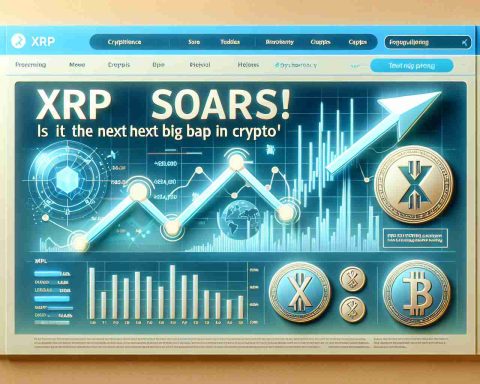Exploring the Surge of XRP Amid Regulatory Changes
In a dramatic turn, the cryptocurrency market soared to a staggering $3.9 trillion in December, recovering from a long period of decline. The catalyst? Donald Trump’s recent presidential election win, which significantly boosted optimism within the crypto community thanks to his pro-crypto stance.
Among the top performers was XRP, the digital currency associated with Ripple, which witnessed an impressive increase of about 530%. This surge has investors speculating about the token potentially reaching a new high of $5.
Ripple has been entangled in a legal dispute with the U.S. Securities and Exchange Commission (SEC) since 2020, facing accusations of breaking securities laws with its XRP sales. While XRP has a fixed supply of 100 billion tokens, the company controls a significant portion. This unique structure differentiates it from decentralized cryptocurrencies like Bitcoin.
In August 2024, a ruling suggested that XRP’s status as a security may vary depending on its use, alleviating some pressure on Ripple. With Trump appointing Paul Atkins—an industry-friendly figure—to the SEC, hopes are high that regulatory challenges could diminish.
Despite XRP’s current market capitalization of approximately $180 billion, reaching $5 would mark a substantial milestone. However, the value of XRP remains speculative, as its success is not solely tied to Ripple’s payment network. As the landscape shifts, investors should remain cautious amidst potential volatility, reminiscent of past dramatic price drops.
Examining the Broader Impact of XRP’s Surge
The recent resurgence of XRP amid shifting regulatory landscapes poses profound implications for society and the global economy. As adoption of cryptocurrencies accelerates, the financial sector is likely to undergo transformative changes. Ripple’s ambition to leverage XRP for facilitating cross-border transactions underscores a growing trend where traditional banking systems may face disruption. This could democratize financial services, particularly in underbanked regions, by providing access to faster and cheaper alternatives.
Culturally, the rise of cryptocurrencies, exemplified by XRP, illustrates a broader shift towards decentralization and autonomy in financial transactions. As consumers become disillusioned with centralized banking systems, there is a growing appetite for alternatives that empower individuals over institutions. This shift reflects a deepening generational divide, with younger stakeholders often championing digital assets and blockchain technologies.
Environmentally, the surge in cryptocurrency trading—while initially concerning due to high energy consumption—may signal the industry’s pivot towards more sustainable practices. Companies like Ripple are increasingly exploring energy-efficient mechanisms, aligning with global sustainability goals.
Looking ahead, as regulatory frameworks evolve, trends suggest that cryptocurrencies like XRP could transcend traditional roles, shaping future economic landscapes. This may lead to more integrated financial ecosystems, yet also warrants careful oversight to mitigate potential market volatility and ensure consumer protection.
Riding the Wave: XRP’s Potential Post-Regulatory Revolution
Exploring the Surge of XRP Amid Regulatory Changes
The cryptocurrency market has seen a remarkable rebirth, achieving a staggering valuation of $3.9 trillion in December, largely fueled by geopolitical changes and regulatory developments. One of the most noteworthy performers during this resurgence is XRP, the token linked to Ripple, which skyrocketed by approximately 530%, capturing the attention of both investors and analysts alike.
XRP’s Legal Landscape and Future Outlook
Ripple’s ongoing legal battle with the U.S. Securities and Exchange Commission (SEC) has overshadowed its operations since 2020. The SEC’s allegations focus on whether XRP should be classified as a security, which carries stringent regulatory implications. However, an August 2024 ruling hinted at a shift in perspective, suggesting that XRP’s classification could depend on its application, shifting some pressure off Ripple and igniting a renewed sense of optimism among investors.
Key Features of XRP
1. Fixed Supply: XRP has a capped supply of 100 billion tokens, a contrast to the inflationary nature of some cryptocurrencies.
2. Ownership Structure: Ripple holds a significant portion of XRP, differentiating it from completely decentralized tokens like Bitcoin.
3. Transaction Speed: Transactions with XRP can be completed in just a few seconds, making it one of the faster cryptocurrencies in the market.
Use Cases of XRP
XRP is designed to facilitate cross-border payments, aiming to streamline and reduce the cost of transferring funds internationally. Ripple’s technology targets banks and financial institutions, positioning XRP as a bridge currency that enhances liquidity and efficiency in settlements.
Pricing Predictions and Market Sentiment
Currently valued at around $180 billion in market capitalization, the speculative nature of XRP’s price comes with vast potential for growth. Market analysts speculate that if XRP breaches the $5 mark, it could trigger heightened trading activity and broader acceptance, propelling its position in the crypto ecosystem.
Pros and Cons of Investing in XRP
Pros:
– Potential for High Returns: Past performance indicates significant price appreciation, attracting speculative investors.
– Real-World Use Case: XRP’s focus on improving cross-border payments adds practical utility.
Cons:
– Regulatory Uncertainty: The ongoing legal battles with the SEC create an unpredictable investment environment.
– Centralization Concerns: Ripple’s control over a large portion of XRP raises questions about true decentralization and governance.
Security Aspects of Ripples’ Technology
As Ripple continues to navigate its regulatory challenges, it emphasizes the importance of security in its payment solutions. Once fully operational without legal hindrances, XRP could enhance transaction security through blockchain technology, minimizing the risk of fraud and increasing consumer trust.
Sustainability and Innovations
In recent discussions, Ripple has been proactively addressing the environmental impact of cryptocurrencies. Innovations aimed at reducing energy consumption during transactions are in development, positioning XRP as a green alternative amidst rising concerns over the ecological footprint of blockchain technologies.
For more information about the evolving landscape of cryptocurrencies and XRP, visit XRP and Ripple.
As the cryptocurrency market evolves, investors and users alike should stay informed of regulatory shifts and technological advancements that could shape the future trajectory of XRP and the broader crypto market.













